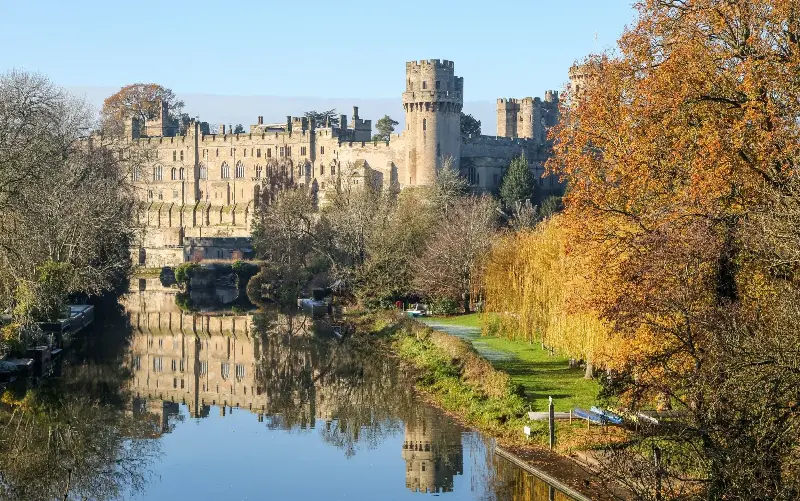
The Government has plans to turn England’s Green Belt grey by smothering it with houses. Chris Packham, worried primarily about bats, suggests we chain ourselves to a tree.
I worry about the England we could lose, the small unspoilt towns, the pretty villages, the magnificent castles, ancient churches, stately homes, moated Tudor manor houses, the gentle countryside that could all be subsumed in concrete. So, before it’s too late, I took myself off to explore what is about to disappear, and I began with the very heart of our green and pleasant land, Warwickshire.
This is, after all, the county of Shakespeare, the setting for the novels of George Eliot, born at Arbury near Nuneaton, and the inspiration for Tolkien’s rural idyll from Lord of the Rings, the Shire (in his words “a Warwickshire village of about the period of [Queen Victoria’s] Diamond Jubilee”).
Although great swathes of Warwickshire have already been lost to Birmingham and are presently being scarred by HS2 construction, there is still much beauty and history to discover, especially in towns such as Henley-in-Arden with its long high street lined with ancient inns and old houses of every style.
Henley recalls the romantic Forest of Arden, which once stretched across much of Warwickshire and beyond, and was beloved of Shakespeare. He set As You Like It in the forest and his mother, Mary Arden, was from the prominent landowning Arden family.
A few miles east lies Warwick, arguably England’s loveliest county town. Sir Walter Scott thought the view from Castle Bridge of Warwick Castle reflected in the waters of the River Avon to be unsurpassed in England. The castle, largely 14th century, is everything a castle should be, with curtain walls and battlements, round towers, dungeons, a Great Hall and a gatehouse with drawbridge and portcullis.
Much of the town outside the castle walls was burned down in 1694 but is still packed with history and beauty. One of the most interesting structures to survive the fire is Lord Leycester’s Hospital, a range of medieval and Tudor half-timbered buildings gathered about a small courtyard. Set up for ex-servicemen by Robert Dudley, Earl of Leicester, in 1571, the hospital today provides accommodation for eight servicemen and their wives, who act as visitor guides.
Adjoining Warwick to the east is stately Leamington Spa, made “Royal” by Queen Victoria in 1838. It is a feast of wide, elegant streets, Georgian and Regency terraces, squares and crescents and riverside gardens gathered around the Pump Room.
To the north are the ghostly ruins of Guy’s Cliffe House, an 18th-century mansion built up against a cliff above the Avon where the Saxon dragon-slayer Guy of Warwick lived as a cave hermit. The house fell into disrepair in the 1950s and was further damaged by fire in 1992 and the resulting ruin, stark and sinister, can be seen from the footpath on the opposite riverbank. Hidden in woods on Blacklow Hill to the north is a monument to Edward II’s favourite, Piers Gaveston, marking the spot where he was run down and beheaded by the Earl of Warwick’s men in 1312.
North again stands one of the grandest fortress ruins in England, the dramatic pink sandstone remains of Kenilworth Castle. Set on a high mound and protected by a great mere, the vast Norman keep of 1162 was strong enough to withstand the longest siege in English history when, for six months in 1266, royalist forces bombarded the garrison held by Simon de Monfort’s men. John of Gaunt built the Great Hall and residential wing in the 14th century and Robert Dudley, Earl of Leicester, turned the castle into a dazzling Renaissance palace where, in 1575, during the most lavish royal visit on record, he entertained his queen with three weeks of hunting, pageantry, fireworks, feasting and dance.
A couple of miles to the east is Stoneleigh Abbey, a spectacular stately home built over the remnants of a 12th-century Cistercian abbey and set in grounds designed by Humphry Repton. All that survives of the original abbey is the substantial gatehouse of 1346 while the Jacobean part of the house, built from the same pink sandstone as Kenilworth Castle, is hidden behind an extravagantly Baroque West Wing of 1726. The highlight of the Baroque wing is the Saloon, considered one of the finest Georgian interiors in England. Jane Austen is said to have used Stoneleigh as the model for Mansfield Park.
A few miles to the west are two eye-catching National Trust properties. The venerable Baddesley Clinton is a Tudor manor house that sits in a wide moat and boasts mullioned windows, timbered gables, tall chimneys and an embattled gatehouse approached by a brick bridge that’s 300 years old. The house belonged to a Catholic family, the Ferrers, and contains a number of ingenious priest holes, including one in the cellars accessed by sliding down a rope in the latrine shaft.
Packwood House, nearby, began life as a farmhouse and was transformed into a timbered, many-gabled mansion by William Fetherstone in about 1570. The timbers have been concealed beneath Jacobean brick, while the interior was refurbished in grand Tudor style in the 1920s. Packwood is famous for its 17th-century Yew Garden, where the clipped yew trees are laid out to represent the Apostles and the Sermon on the Mount.
The Green Belt to the north that separates Birmingham and Coventry is dotted with interesting villages which, while not perhaps as picturesque and peaceful as they were in Tolkien’s day, still retain considerable village charm.
Affluent Knowle’s attractive high street winds past the old Red Lion Inn, the village church famous for its large, beautifully carved 15th-century oak screen and an ancient Guild House of 1413. Also the magnificently timbered Chester House, now the library, which dates back to 1400.
Temple Balsall boasts a rare church founded by the Knights Templar in the 12th century, with corbels displaying remarkably well-preserved and life-like faces of bearded knights.
Berkswell is a delight of pink brick and timber and boasts one of the finest Norman churches in the land. A much photographed two-storey timber porch shelters a Norman doorway while inside there is a unique double-chambered vaulted crypt, part Saxon and part Norman.
Privately owned Maxstoke Castle to the north is a perfectly preserved 14th-century moated castle that was once the home of Margaret Beaufort, mother of Henry VII. Closely linked to Packwood House (see above) since the 18th century when William Dilke of Maxstoke married Mary Fetherstone-Leigh of Packwood, the castle is open for pre-booked tours.
Hampton in Arden lies deep amongst the trees of what is left of the Forest of Arden and is perhaps the best-surviving example of what forest villages once looked like, with rows of overhanging 17th-century cottages lining the main street.
And Meriden, we are informed by a sandstone cross standing on the village green is, by tradition, the Centre of England. A description that also applies to Warwickshire – in more ways than one.
Where to stay
The Globe in Warwick has an excellent location in the centre of town, comfortable boutique rooms and Mediterranean-inspired restaurant. Doubles from £194.
The Chesford Grange Hotel is a country house hotel and spa in spacious grounds between Warwick and Kenilworth. Doubles from £102.
